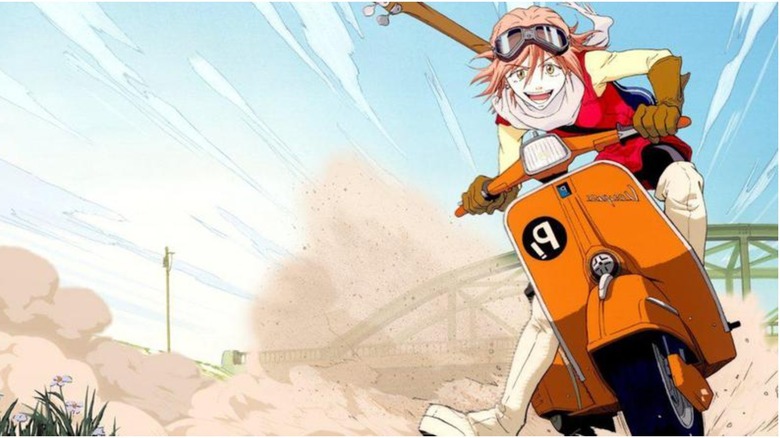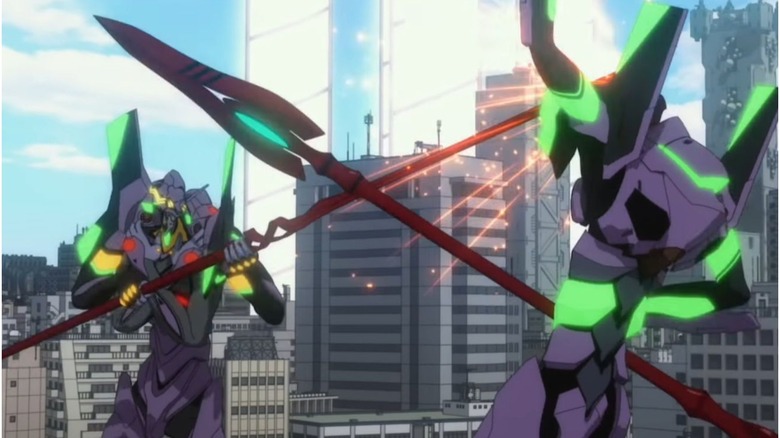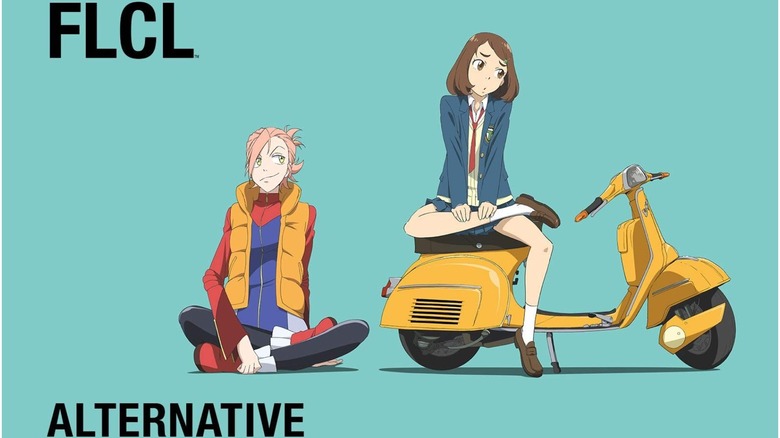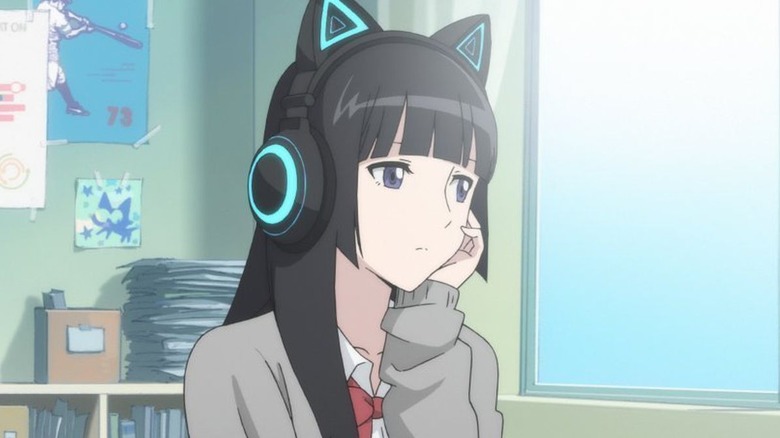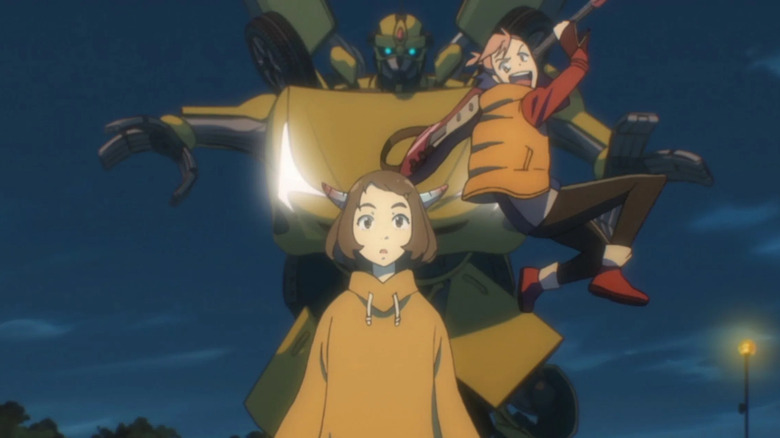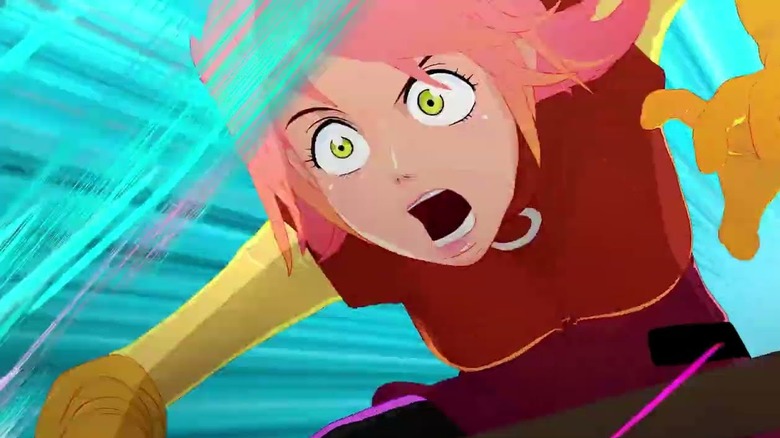Creating A Follow-Up To FLCL Was Even Tougher Than It Sounds
One of the challenges newcomers often have with getting into anime is the sprawling length of many series. No such problem exists with "FLCL," which ran a mere six episodes from 2000 to 2001. The series is a sci-fi coming-of-age drama, but the actual story isn't what's important; it's the hyperactive, deranged animation, which constantly shifts styles and bends physics while the characters break the fourth wall. This experimental animation is fitting considering three different studios produced the anime: Gainax, King Records, and Production I.G.
"FLCL" arrived in the U.S. in 2003 on Cartoon Network's Adult Swim block. 15 years later, Adult Swim partnered with Production I.G. to make two new "FLCL" seasons, subtitled "Progressive" and "Alternative." Making these sequels was not an easy task.
A clash between Gainax and Khara
To understand how we got the "FLCL" sequels we did, let us first look at how the pieces came into place behind the scenes. By 2015, Gainax was no longer the dominant animation studio it was when "FLCL" premiered. Many staff had left the company, including co-founder Hideaki Anno, who took Gainax's most profitable series, "Neon Genesis Evangelion," with him to a new studio, Khara. Gainax's precarious standing allowed Production I.G. to buy the rights to the series from them. Not that they were the only ones interested.
Anno was not a creative driving force on "FLCL" — he is credited as a mere animator and had an uncredited voice role as Miyu-Miyu the cat. However, he mentored the series' director Kazuya Tsurumaki. Tsuruamki's experience as an assistant director on "Evangelion" clearly shaped "FLCL." Indeed, before Production I.G. acquired the series, Khara was in negotiations to buy the rights to "FLCL" from Gainax; the plan fell through after Gainax raised their asking price. While Tsuruamki still wound up returning for the sequels, "FLCL" follow-ups produced at Khara would've doubtlessly been different from "Progressive" and "Alternative."
Production I.G. And Adult Swim Unite
While "FLCL" is respected in Japan, it's beloved in the United States. It's a favorite of Bryan Konietzko and Michael Dante DiMartino, co-creators of the famously anime-flavored "Avatar: The Last Airbender." Even Jason Griffith, who voiced Masurao in "FLCL: Progressive," admitted in an interview with Toonami Faithful that, "in Japan, 'FLCL' is not as big of a deal as it is here." This means that Adult Swim taking an active role in the production of the series, not just the dubbing, was a natural choice; the sequels were as much for their benefit as they were that of Production I.G.
The different reputations that "FLCL" holds in the East and West means that the two teams had different expectations when working on the sequels. In the aforementioned interview, Griffith elaborated: "Part of our job is reminding them 'remember, you have a lot to live up to' and making sure they were pouring everything they had into it. And they did, they really stepped up." Aside from those reminders, the production went smoothly. Adult Swim gave Production I.G. a wide berth when it came to the hands-on work and were satisfied by the results.
Who returned and who didn't
"FLCL Progressive" and "Alternative" follow an anthology format. Rather than directly following up on the original, the sequel places Haruko Haruhara, the guitar-wielding alien who stole the heart of Naota and many fans, alongside different supporting casts. This allows both sequels to reuse the coming-of-age arc that defined the original "FLCL."
While many characters may not have returned, the production team was a different story. Tsuruamki oversaw the project while character designer Yoshiyuki Sadamato sketched the new casts. Japanese rock band The Pillows, who'd given the first series its head-banging soundtrack, returned to score the sequels. Stephanie Sheh, who voiced Mamimi in the English version original series, returned for the dub even when her character didn't; this time, Sheh mostly worked the other side of the recording booth as an ADR director. There were some absences: original screenwriter Yōji Enokido was replaced by Hideto Iwai, while Haruko's Japanese voice Mayumi Shintani bowed out for "Progressive" (she returned in "Alternative"). No such recasting for the dub, though. Haruko was Kari Wahlgren's debut role, and she was eager to return to it.
With so much passion behind the sequels and with many of the original crew involved, what could go wrong?
Progressive wasn't so progressive
Despite its subtitle, "FLCL: Progressive" is more interested in hitting the beats of the original; it's to "FLCL" what "The Force Awakens" is to "Star Wars." The series picks up in the town of Mabase, where nothing amazing has ever happened; at least since the events of "FLCL" season 1. 14-year-old Hidomi Hibajiri takes on the protagonist role from Naota, but personality-wise she's closer to Mamimi; a depressed, almost emotionless teenage girl. Of course, her life changes once Haruko enters it.
Now, "Progressive" is not a wash. There's plenty to like, from the character designs (especially Hidomi's adorable cat ear headphones, which turn out to be more than meets the eye) to the music, old and new (ending theme "Spiky Seeds" is a worthy successor to "Ride On Shooting Star"). "Progressive" has the same hilarious mix of deadpan humor and off-the-wall comedy as the original "FLCL"; Wahlgren's Haruko is the funniest of all.
Ultimately, though, "Progressive" has but a fraction of the original's imagination. It's a more conventionally animated series, and slower-paced on a scene-by-scene basis; "FLCL" ran at an unrelenting mile a minute speed, while "Progressive" flows like a typical anime. Instead of breaking boundaries, the series is constantly trying to remind you of the original, from the aerial battle between Haruko and her other self Jinyu in episode four mirroring the climax of season 1 to the manga sequence in episode five. The magic of "FLCL" was its experimentation, its refusal to obey form or convention. "Progressive" is too enamored by its predecessor to break any new ground. The lesson is the same as most other legacy sequels: Reverence for the material doesn't bring equal quality.
Alternative tries something new
The third season of "FLCL," "Alternative," focuses on 17-year old girl Kana Koumoto and her three friends: Mossan, Hijiri, and "Pets." Kana is the oldest "FLCL" protagonist, but also the one who clings most to the safety of childhood. Whereas Naota was eager to grow up and Hidomi was directionless, Kana wants everything to stay the same. "Alternative" is not as funny as "Progressive," and its animation still doesn't match how bonkers the original was. However, it has more things on its mind than just being "FLCL."
The first four episodes often feel more like a high school slice of life anime than "FLCL," not helped by how incidental Haruko's presence is. However, the series' vision becomes clear in the final two episodes. There are two main threads throughout "Alternative." One, Kana inserts herself into one of her friends' lives and makes their problems worse. Two, the rich are planning to flee Earth for Mars to avoid an impending apocalypse. "Progressive" featured modern touches like smartphones, but "Alternative" taps into the zeitgeist of the 2010s; the world is slowly ending and there's nothing you can do.
In episode five, "Shake It Off," Kana discovers Pets will be one of those leaving for Mars. When she confronts her friend, Pets calls out Kana for intruding on her friends' lives with nothing but self-regard and admits she regrets ever becoming Kana's friend. Kana can only dream of reconciliation.
The first 10 minutes of episode six, "Full Flat," features the cast awaiting the apocalypse, finding little solace in routine or each other. Haruko, however, refuses to let the story have a downer ending. With some encouragement, Kana accepts herself and saves the world, "Everything I did was an act, it was annoying, I can admit that now – and I'm no longer scared of not being liked!"
More sequels to come
After "Alternative," it seemed "FLCL" was over; the third season even contained some hints that it was actually a prequel to the original. If one subscribes to that interpretation, then the three seasons play as a continuous loop. However, that loop is about to be broken.
Adult Swim announced on March 17, 2022, that two new seasons of "FLCL" are in production and will premiere in 2023. The subtitles, "Grunge" for season 4 and "Shoegaze" for 5, keep up the music motif of "Progressive" and "Alternative." Notably, "Grunge" will be produced by Montblanc Pictures instead of Production I.G. For "Shoegaze," however, Production I.G. will return alongside Studio NUT, who worked on "Alternative."
Accompanying the announcement was a ten-second teaser for "Grunge," showing Haruko jumping through the air wielding a katana while "Ride On Shooting Star" plays. While there's no hint of any story, the teaser indicates that "Grunge" will be 3-D animated. This is a major break from the style of the first three seasons. However, the whole ethos of "FLCL" is to push animation as far it can go; the original series looped from typical anime to motion manga to a "South Park" parody then back around again. Using CGI to bring "Grunge" to life is a natural step forward. If Montblanc carries through that spirit of experimentation, "Grunge" could be the most successful "FLCL" sequel yet.
